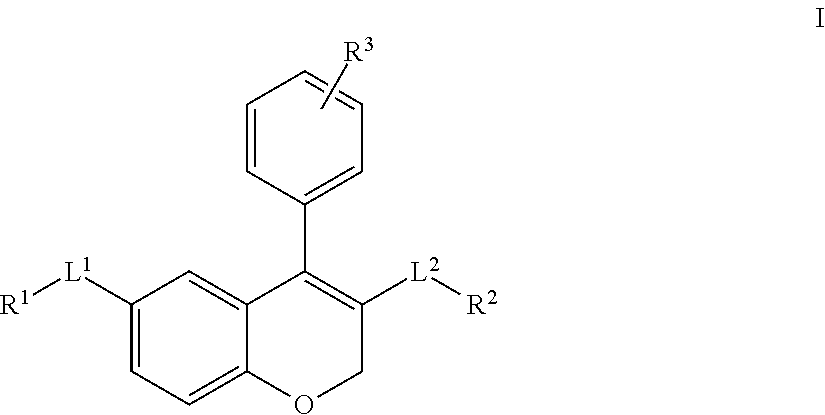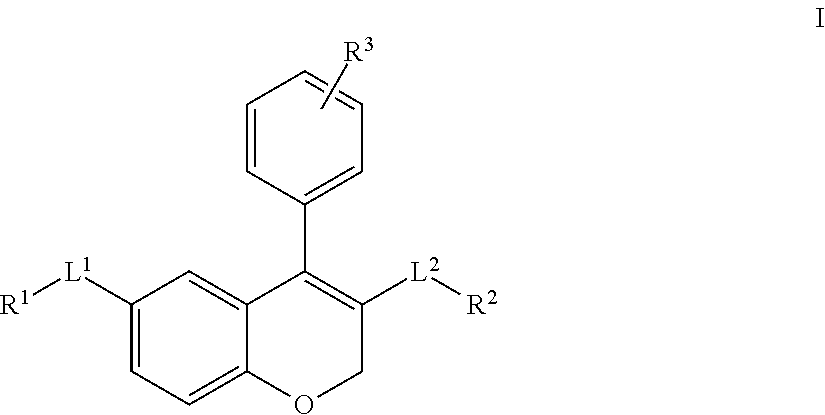Chromene derivatives as inhibitors of tcr-nck interaction
- Summary
- Abstract
- Description
- Claims
- Application Information
AI Technical Summary
Benefits of technology
Problems solved by technology
Method used
Image
Examples
example 1
ethylamino)ethyl)-4-(4-fluorophenyl)-6-(trifluoromethoxy)-2H-chromene-3-carboxamide
[0396]
Step 1: Synthesis of 3-(4-(trifluoromethoxy)phenoxy)propanoic acid
[0397]Chloropropanonic acid (24.49 g, 224.7 mmol) in 2N NaOH (100 mL) was added drop wise over 10 min at 100° C. to a well-stirred mixture of 4-(trifluoromethoxy)phenol (compound 1; 20 g, 112.35 mmol). The reaction was stirred for 4 h at 100° C. On completion the reaction mixture was cooled to rt and acidified to pH 2-3 using IN HCl. The resulting solid precipitated was collected by filtration; yielding 4 g of crude compound 2 which was used directly in the next step without any further purification.
Step 2: Synthesis of 6-(trifluoromethoxy)chroman-4-one (compound 3)
[0398]Triflic acid (2.14 mL) was added drop wise over 10 min to a well-stirred mixture of compound 2 (4 g, 16.06 mmol) in TFA (4.56 g, 40.0 mmol) at 0° C. The reaction mixture was stirred for 24 h. On completion the reaction mixture was poured into cold H2O (100 mL) and...
example 2
fluorophenyl)-6-(trifluoromethoxy)-2H-chromen-3-yl)methyl)-4-methylpiperazine
[0403]
Step 1: Synthesis of 3-(chloromethyl)-4-(4-fluorophenyl)-6-(trifluoromethoxy)-2H-chromene
[0404]Sodium borohydride (0.5 eq.) in toluene (20 mL), was added drop wise at rt to a mixture of compound 5 (3 g, 1 eq.) in methanol (2 mL). The reaction was stirred at rt for 2 h. The reaction was monitored by TLC; on completion the reaction mixture was poured into cold water (100 mL) and extracted with ethyl acetate (2×30 mL). The combined organic layers were washed with water (20 mL) and brine solution (10 mL), then dried over anhydrous Na2SO4. Evaporation of the organic layer under reduced pressure yielded 2.7 g of the desired product. This material was used directly in the next step without any purification or analysis. The crude compound (2.7 g) was dissolved in toluene (30 mL). To this mixture, thionyl chloride (1.78 g, 1.4 eq.) was added drop wise at 0° C. and stirred at rt for 2 h. The reaction was monito...
example 3
fluorophenyl)-6-(trifluoromethoxy)-2H-chromen-3-yl)methyl)morpholine
[0406]
Synthesis of 4-((4-(4-fluorophenyl)-6-(trifluoromethoxy)-2H-chromen-3-yl)methyl)morpholine (I-16)
[0407]The mixture of compound 7 (0.4 g, 1 eq.), K2CO3 (0.5 g. 3 eq.), and morpholine (0.13 g, 1.2 eq.) in diisopropyl ether (4 mL) was stirred at rt for 15 h. The reaction was monitored by TLC; on completion the reaction mixture was poured in to cold water (20 mL) and extracted with ethyl acetate (2×30 mL). The combined organic layers were washed with water (20 mL) and brine solution (10 mL), and then dried over anhydrous sodium sulfate. Purification of the crude product by column chromatography yielded 20 mg of 1-16.
PUM
| Property | Measurement | Unit |
|---|---|---|
| Angle | aaaaa | aaaaa |
| Pharmaceutically acceptable | aaaaa | aaaaa |
| Interaction | aaaaa | aaaaa |
Abstract
Description
Claims
Application Information
 Login to View More
Login to View More - R&D
- Intellectual Property
- Life Sciences
- Materials
- Tech Scout
- Unparalleled Data Quality
- Higher Quality Content
- 60% Fewer Hallucinations
Browse by: Latest US Patents, China's latest patents, Technical Efficacy Thesaurus, Application Domain, Technology Topic, Popular Technical Reports.
© 2025 PatSnap. All rights reserved.Legal|Privacy policy|Modern Slavery Act Transparency Statement|Sitemap|About US| Contact US: help@patsnap.com



